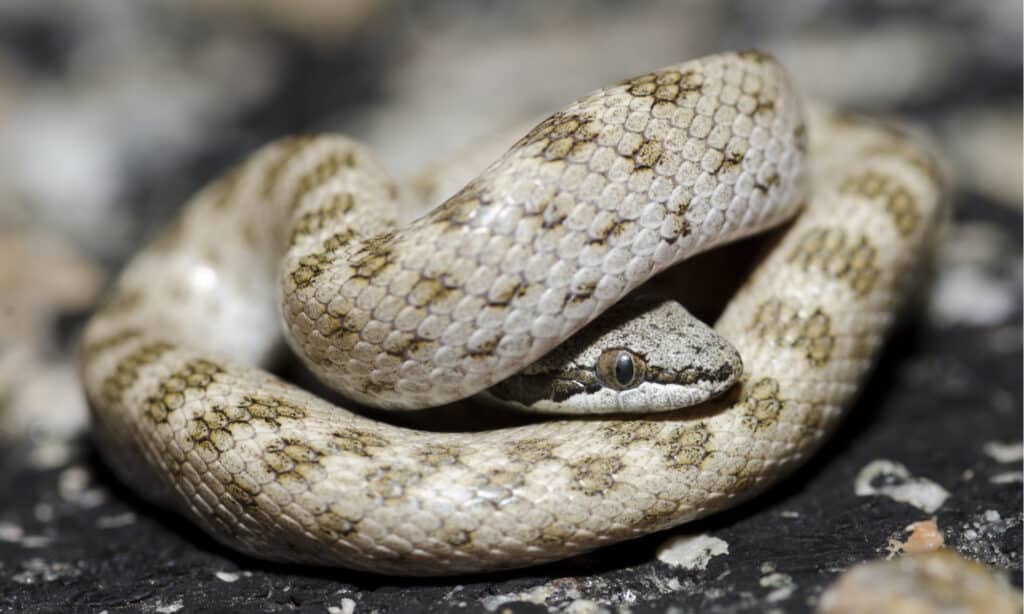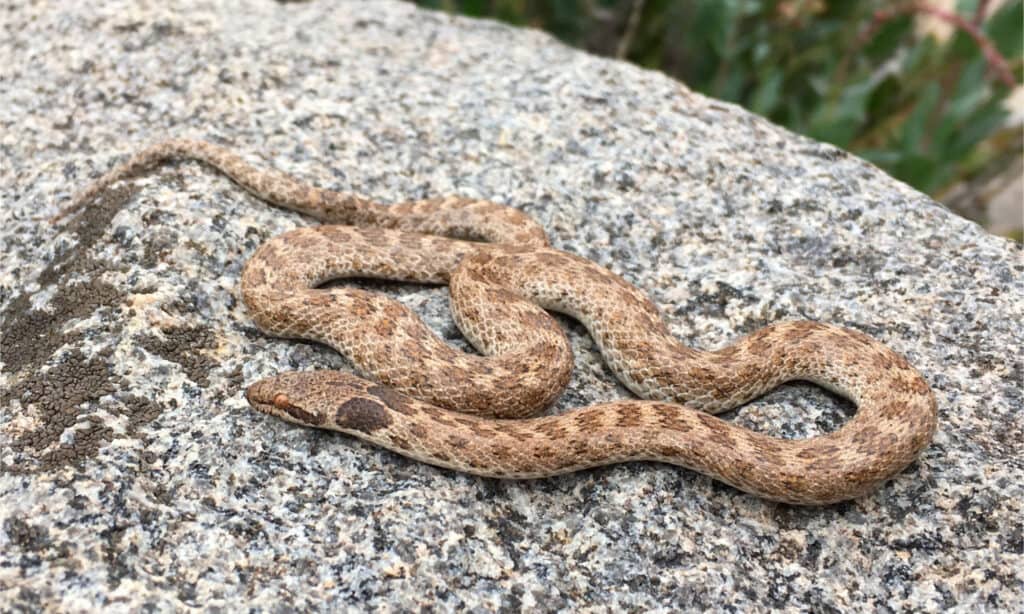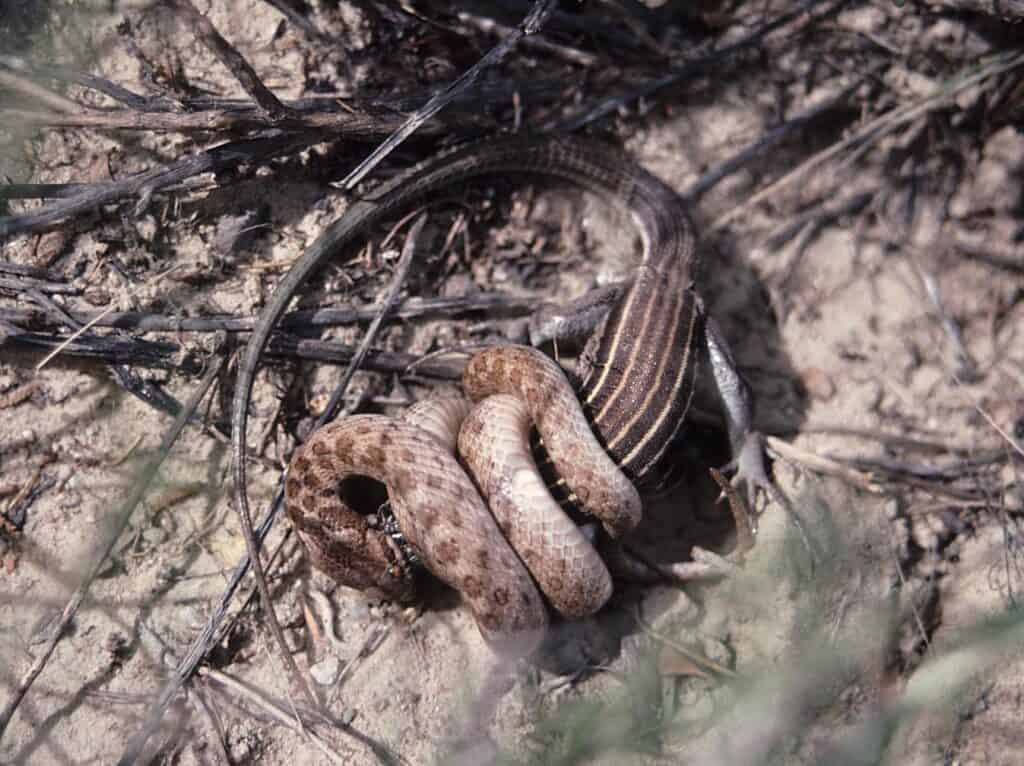Our planet is home to some magnificent snakes of varying appearances, behaviors, and sizes. Although many people have ophidiophobia (a fear of snakes), snakes are essential to maintaining the equilibrium of Earth’s ecosystems. Encountering snakes anywhere in the world is nothing unusual, particularly in Africa, Asia, or the Americas, with lengths ranging from a few inches to as long as a school bus.
You may be familiar with the most well-known ones, such as pythons and boas, which serve as hosts to the largest snakes. Measuring them by weight or length determines which family has the most enormous reptiles. However, we bet you’ve never heard of night snakes. Which reminds us of an incredibly rare question: what is the largest night snake ever recorded?
Background On Night Snakes

Night snakes are members of the extremely vast Colubridae family.
©Jason Mintzer/Shutterstock.com
The scientific name for the night snake is Hypsiglena torquata, and torquata is the Latin word for collar or neck chain. It describes the two broad, dark-brown spots at the snake’s base, which give the snake the appearance of having a collar. They are primarily nocturnal (active at night), as their common name suggests.
Night snakes are members of the extremely vast Colubridae family. Within that family, the Hypsiglena genus contains at least 17 different varieties of night snakes, and among these 17 types of night snakes, the spotted night snake is the largest. This article will explore the size of the largest night snake, its habitat, and other fascinating facts.
What Do Night Snakes Look Like?

Night snakes are mistaken for baby rattlesnakes.
©Matt Jeppson/Shutterstock.com
Often, night snakes are mistaken for baby rattlesnakes, which can be a concern. While the former is not lethal to humans, the latter is exceedingly venomous. The night snake has a thin snout that gradually becomes wider until it reaches the base of the snake’s head, which shapes it into a triangle.
Additionally, the night snake has a white belly, and the pupils of its eyes are elliptical. This snake has light brown or dull gray scales, and on its back, it has a pattern of dark brown spots. It has a dark stripe connecting to each eye’s edge and two sizable dark brown splotches at the base of its head.
What Is The Largest Night Snake Ever Recorded?
Generally, the night snake often has a thick body and measures 12 to 26 inches in length. And although no particular night snake has been recorded to be the largest of them all, the only subspecies that can grow to a maximum size of 26 inches is the spotted night snake. The other subspecies, such as the Texas night snake, California night snake, and San Diego night snake, are smaller, and can only reach a maximum length of 16 inches.
Night snakes are considered small, commonly no greater than 26 inches, a size that’s generally too small to allow for comfortable handling. While there are no in-depth descriptions of the largest night snake, there haven’t been any subsequent reports of similar snake species sightings growing longer than the maximum length revealed.
Where Do Night Snakes Live?
The western and southern regions of the United States are home to night snakes, and their distribution extends from the states of Washington to Idaho and through California to Utah, continuing southward to Texas. Another location where they thrive is in northern Mexico. The last one is Canada’s British Columbia, where night snakes can also be found and are considered the province’s smallest snakes. However, little is known about population numbers and exact ranges due to the night snake’s extremely cryptic nature.
The night snake thrives in various habitats, such as grasslands, deserts, sagebrush flats, chaparral, forests, thorn scrub, and mountain meadows. Night snakes live in rocky and sandy regions and have been seen as high as 8,500 feet (2,600 meters). The night snake may live in either a tropical or temperate climate and is known to live in mammal burrows.
What Do Night Snakes Eat?

Night snakes primarily eat lizards.
©ALAN SCHMIERER / flickr – License
The primary food source for night snakes are lizards, and other prey includes salamanders, frogs, baby rattlesnakes, blind snakes, and big insects. The night snake’s mildly venomous saliva aids in the capture of small prey, such as amphibians and reptiles. They forage from mid-April to mid-September, emerging at dusk to roam around their habitats in search of prey. The night snake uses its sense of smell to find small animals after the sun sets and swallows its prey after dying.
How Do Night Snakes Behave?
Crepuscular (more active at dawn and dusk) and nocturnal are both characteristics of night snakes. In addition to being seen at night while crossing highways, they can also be discovered during the daytime behind rocks, boards, dead branches, and other surface debris. The winter is when night snakes hibernate, while the summer is when they are known to aestivate. They are typically most active from April through October, with June being the typical month of activity spikes. If a night snake feels threatened, it may coil up and thrust its body in the threat direction while flattening its head into a triangle defensive configuration.
However, night snakes are easily frightened. They have drawn interest from some reptile enthusiasts as pets due to their calm disposition and small size. Keep in mind that pet snakes require special maintenance. For them to be healthy, their habitat must be temperature-controlled, have the perfect amount of humidity, and serve as a source of proper nutrition.
Are Night Snakes Dangerous?
Although they have a small amount of venom, night snakes are not dangerous to humans. Only their prey, including lizards, frogs, and small snakes, are at risk from the venom that oozes from their rear fangs. In other words, the venom of a night snake bite is not likely to cause any harm to a human. Even so, the snake bite requires attention and care.
The first step is to wash the bite wound with warm water and soap. After that, dab first-aid cream on the wound and wrap a bandage around it. Keep an eye out for excessive redness or inflammation since these symptoms may lead to an infection. Visit a doctor for additional care if either of these symptoms intensifies.
Other Record-Breaking Snakes

The Eastern indigo snake is a long, somewhat thin snake with large smooth blue-black scales that are iridescent purple in the light.
©Patrick K. Campbell/Shutterstock.com
The Eastern indigo snake (Drymarchon couperi) is a large, nonvenomous species of colubrid snake native to the southeastern United States. It is the longest native snake species in the U.S., reaching up to 8 feet in length and weighing up to 13 pounds. The eastern indigo snakes are typically black or dark blue, with pale yellow scales along their sides that can create interesting patterns, though some may have more vibrant colors such as orange or red mixed into their patterning.
The largest eastern indigo snake ever recorded was found near Ocala National Forest in Florida in 2019 by scientists from the University of North Florida’s Department of Biology. It measured an impressive 8 feet 3 inches long and weighed 14 pounds 4 ounces – making it both longer and heavier than any other known individual! This record-breaking discovery demonstrates just how large these majestic creatures can grow when given enough space. Eastern indigos are currently listed as threatened under U.S. law due to habitat loss, so efforts must be made to protect their populations and ensure they have adequate habitat for them to thrive.
The photo featured at the top of this post is © Matt Jeppson/Shutterstock.com
Discover the "Monster" Snake 5X Bigger than an Anaconda
Every day A-Z Animals sends out some of the most incredible facts in the world from our free newsletter. Want to discover the 10 most beautiful snakes in the world, a "snake island" where you're never more than 3 feet from danger, or a "monster" snake 5X larger than an anaconda? Then sign up right now and you'll start receiving our daily newsletter absolutely free.
Thank you for reading! Have some feedback for us? Contact the AZ Animals editorial team.







